Along with modern technology development, more and more steel entrepreneurs induce advance processes to improve product quality and plant efficiency. For steel bar production line, the following processes are used commonly.

Direct rolling technology is suitable for production lines to make plain carbon steel and low alloy steel.This process divides into three situations, one is the presence of conventional heating furnace and induction heating at the same time; the second is the absence of conventional heating furnace, only by induction heating for continuous casting billets to reheat; the third is not to take any heating measures, the casting billet directly enters into the mill to be rolled rolling.
If there is no heating furnace between the CCM and rolling mill, only induction heaters to raise the temperature of the billet. This arrangement must require a strict match between steelmaking and rolling capacity, its production organization is more difficult.
For direct rolling process without induction heating case, try to make cutting point located at the solidification critical point, moving the conventional cutting point forward and increasing the temperature of the continuous casting billet itself. The transport time of the billet on the table after cut-to-length is controlled within 2min and the temperature drop should be less than 50℃. If the table length is rather long, insulation covers can be added and the average temperature of the billet section to the entrance of the mill can reach 1000-1050°C to meet the rolling requirements.
Rectangular billet or square billet through multiple continuous rolling, into the rectangular section of the middle plate, after four racks of multi-line slitting rolling and cooling, to get the finished threaded steel bar. The other method is single line high speed headless rolling bar or wire. This process has the following advantages.
To apply the headless rolling process can improve the weight of the coil and mill output. As a result of the elimination of the dynamic speed reduction caused by biting rolling piece moment, the continuous rolling course is stable and tension fluctuation reduces, thus that is easy to increase rolling speed.
Because there is no gap time between two adjacent rolling pieces, eliminating the cutting of the head and tail of the rolling pieces, eliminating the trimming of the head and tail, the mill utilization rate increases by more than 3% and the production capacity increases by 2%-5%; the weight of the coils can be adjusted according to the requirements by fly shear.
Lessening shocked times of rollers and guides by the rolling pieces with low temperature, thus that can reduce parts cost.